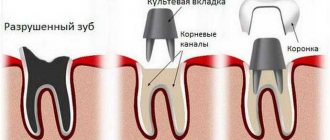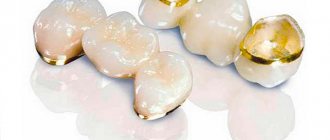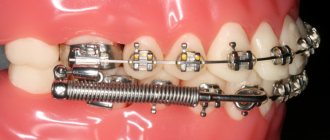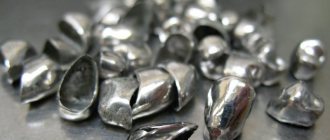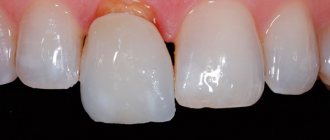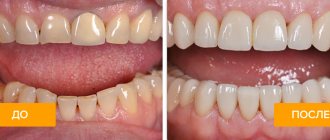I recommend placing a crown on a living tooth if:
- Destruction of
the crown part of the tooth
more than 55%
(trauma, caries, large chip, crack) with normal pulp condition. - Intensive abrasion of enamel
. - The tooth serves as a support for attaching the bridge.
In addition, orthopedic structures using crowns are placed on loose teeth during the treatment of the underlying disease that caused tooth mobility. Sometimes it is possible to place crowns on severely crooked teeth.
Crown for a living tooth
When to place a crown on a living tooth
Stages of installing a crown on a living tooth
Types of crowns. Their pros and cons
When does pulp need to be removed?
Myths about dental crowns
The question of whether it is possible to put a crown on a living tooth has gathered many myths and prejudices and divided people into two camps. When you can put a crown on a living tooth, and when not, what are the pros and cons of both methods, we will consider in this article.
First, let's figure out what a living tooth means. A tooth is an organ consisting of a protective layer (enamel, dentin, cement) and a neurovascular bundle (pulp). A tooth is considered alive if the pulp is preserved, and dead if the pulp is removed - this procedure is usually carried out in the treatment of pulpitis and periodontitis.
Realities and myths
Most patients associate prosthetics, and especially if depulpation is excluded, with unpleasant sensations, pain and even fear.
This condition is explained by the need to remove part of the dental tissue, so many people refuse this method of tooth restoration, commenting on the following reasons:
- A tooth covered with a crown deteriorates and rots faster. This phenomenon does occur, but only if the procedure is carried out incorrectly and there is no proper care for the oral cavity.
Destruction is also possible due to inadequate preparation of the tooth for prosthetics, poor quality of the prosthetic product, or refusal to install a temporary crown. - To install a crown, a large amount of tissue will be removed from the tooth .
Dentistry today is focused on maximizing the preservation of dentin layers. Modern equipment and tools make it possible to control the amount of fabric stitching, and to carry out this procedure more carefully and accurately. In addition, materials for prostheses have also changed. Thus, the metal-ceramics became thinner, which enabled more gentle grinding behavior. - After the crown is removed, the tooth will need to be removed . If the border of the prosthetic product has not dropped, and the preliminary grinding of the tooth is done as carefully as possible, then repeated prosthetics will be successful in a few years, i.e. without the need for removal.
- Depulpation of a tooth that is to be covered with a crown is a mandatory procedure . Action is mandatory only if there are certain indications. Thanks to the introduction of innovative technologies in dentistry, attaching a prosthesis to a vital organ is not a problem.
- If caries has developed under the crown, the disease cannot be cured. It is possible, but the treatment method depends on the severity of the pathology.
In most cases, removal of the prosthesis and its subsequent replacement after completion of treatment is required. Often, caries can be eliminated in another way - without removing the orthopedic structure, treatment is carried out through the hole on the chewing surface. - Instead of a crown, it is better to put several fillings. From a financial point of view, filling is cheaper, but loses in efficiency. Fillings, even large ones, cannot withstand heavy chewing loads, which is why they split themselves and lead to the walls breaking off.
Important! The crown maintains uniform load distribution and protects tissue from destruction. If the tooth is severely damaged, fillings are not recommended.
All the considered reasons that underlie patients’ refusal to have crown prosthetics are misconceptions. It should be understood that only a dentist can offer the optimal treatment method, based on the results of the examination and visual examination.
From the video, find out the opinion of a specialist about whether it is necessary to kill the tooth under the crown.
When to place a crown on a living tooth
A crown is a permanent cap-shaped structure that is similar in appearance to a natural tooth. Typically, a crown is installed on severely damaged teeth, when restoration with conventional filling materials is impossible or ineffective, since due to heavy loads, cracks may appear on the filling.
Indications for crown installation
- the tooth is destroyed by caries by more than 50%;
- the tooth is destroyed as a result of injury;
- the tooth has become gray or yellow, and stands out strongly against the background of other teeth.
Often, before installing a crown, the tooth is depulped, that is, the neurovascular bundle is removed from the root canals. However, in some cases this procedure is not carried out. The decision whether to perform depulpation or not is made by the doctor, based on clinical indications.
Cases when a crown is placed on a living tooth:
- the tooth is healthy, but due to destruction it cannot perform its functions;
- demineralization and fragility of enamel;
- using a tooth as a support for a bridge;
- destruction of the crown as a result of mechanical trauma;
- tooth loosening due to gum disease.
Why put a crown on a living tooth?
The neurovascular bundle (pulp) is the tissue that is located inside the tooth. It performs several functions: it delivers nutrients to the tooth and protects it from pathogenic microorganisms. After removal of the pulp, the tooth becomes fragile and vulnerable, as it is left without protection and does not receive nutrition, which leads to the destruction of enamel and the rapid development of caries. Therefore, preserving the pulp is a guarantee that the tooth can serve for many more years.
Sometimes after prosthetics, patients complain of toothache and swelling of the gums. This has nothing to do with the fact that the tooth was not pulpless. The main reasons are untreated diseases, incorrect technique when grinding down the enamel, and damage to the canals during preparation. If you experience these symptoms, you should make an appointment with your doctor.
Restoring part of a “dead” tooth with a filling
Before the restoration begins, endodontic treatment (canal treatment of the tooth) is carried out.
If the “nerve” was removed previously, the dentist will check the quality of the root canal treatment and, if necessary, perform re-treatment. We talk about the complexity of endodontic treatment in the article Why it is impossible to give a 100% guarantee for tooth root canal treatment.
If less than 50% of the crown part of the tooth is destroyed, the lost part can be qualitatively restored using composite filling materials.
Modern filling materials allow the dentist to accurately select the color and transparency of the part of the tooth being restored, to recreate the surface structure and anatomical shape, ensuring the correct bite and contact points with neighboring teeth.
Restoring a tooth with a filling requires the dentist to have a good knowledge of dental anatomy and the skill of a sculptor.
The filling will last 5–7 years
What affects the service life of a filling, when and why it will require replacement, you will learn from the article “Why change an old filling if everything is fine and the tooth is not bothering you?”
Stages of installing a crown on a living tooth
Installing a crown will require several visits to the dentist
Table 1. Stages of installing a crown on a living tooth
| Stage name | Procedures |
| Initial examination and diagnosis | Consultation with an orthopedist, examination of images, development of a treatment plan |
| Preparing to install a crown |
|
| Preparing a tooth for a crown | Using a drill, the doctor shapes the tooth so that the crown can be firmly attached to it. To do this, a layer of enamel is removed, the thickness of which depends on the thickness of the future crown. The procedure is performed under local anesthesia. |
| Making crowns | After preparation, the doctor takes impressions. Based on them, a plaster model is first made in a dental laboratory, and the crown is cast from it. If making a crown takes several days, the patient is given a temporary crown, which protects the tooth from bacteria and mechanical damage. |
| Fitting and fixation | Before installation, the doctor tries on the crown on the tooth. If the patient does not feel discomfort during fitting, the crown is fixed to the tooth using dental cement. |
Stages of the procedure
Based on the casts, a model of a permanent prosthesis is created in the laboratory from plaster. Since metal ceramics or zirconium dioxide are used for this, the manufacturing process can take several weeks.
Before finishing the work, the technician, together with the dentist, conducts two fittings:
- The first is to try on the crown frame.
- The second is when an almost finished prosthesis is tried on, when layers of ceramics and dyes are applied to the frame.
It is during the second fitting that the correct selection of the crown color and its shape is checked. Upon completion of the inspection, the structure is sent back to the laboratory, where the final manipulations for its creation take place - glazing and polishing.
At the next visit, the permanent crown is secured, but with temporary cement. This measure allows you to assess the level of comfort when wearing the structure, the correctness of its position in relation to neighboring units, and also eliminate the possibility of allergies.
If any problems are discovered or the patient makes complaints, urgent measures are taken to eliminate them. If no side effects are observed, the prosthesis is permanently fixed.
Types of crowns. Advantages and disadvantages
Metal-ceramic crowns are rarely installed on a living tooth, since before installing such products, a significant layer of enamel must be removed. Therefore, metal-free structures are most often used: ceramics and zirconium dioxide.
| Ceramic crowns ➕ High aesthetics. Such crowns are indistinguishable from natural teeth. They are very light and almost imperceptible in the mouth. Ceramics can be used for people prone to allergies. ➖ high cost and fragility of the product. Ceramic crowns are not suitable for chewing teeth. |
| Zirconium dioxide crowns ➕ Considered the most in demand. Zirconium dioxide is a very strong and durable material. Just like ceramics, it looks natural, does not require significant grinding of teeth, and is hypoallergenic. ➖ high cost, not suitable for restoration of anterior teeth. |
When does pulp need to be removed?
Depulpation is not a mandatory procedure before prosthetics, but it cannot be avoided if there are the following indications.
- Advanced caries or caries at the very root of the tooth.
- Pulpitis or periodontitis.
- Partial exposure of nerves during grinding of enamel.
- Anatomically incorrect position of the tooth.
- Tooth injury, which may result in partial death of the nerves.
- Hypersensitivity.
- Low landing crown.
If there is a need to remove the nerve after the crown has been installed on a living tooth, then depulpation can be carried out without removing the crown. The doctor makes a hole, removes the nerve, and then fills the hole with polymer. After such a procedure, the prosthesis does not lose its performance properties.
Direct indications for depulpation
Dentists decide to remove a neurovascular bundle only if the patient:
- the nerve is partially exposed;
- tooth hypersensitivity;
- caries has reached the root canal;
- mechanical damage to the unit;
- anatomical pathologies (improper position of the tooth, large canal inclination).
The dentist is especially careful in choosing the method of prosthetics for the tooth that is planned to be used as a support for the structure.
